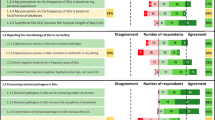Abstract
Background
There have been increasing reports of methicillin-resistant Staphylococcus aureus (MRSA) infections in the community, but it is unclear whether infectious organisms in open fracture infections have changed and if our current regimen of antibiotic prophylaxis is therefore obsolete.
Questions/Purposes
We determined the recent incidence of MRSA and Gram-negative organism infections after open fractures.
Methods
We performed a retrospective cohort study on 189 patients with 202 open fractures treated from 2009 to 2010. During the followup, patients were evaluated for signs of infection using the Centers for Disease Control and Prevention criteria. We determined the organisms using routine microbiology culture. The minimum followup was 3 months (median, 47 months; range, 3–108 months).
Results
Of the 202 open fractures, 20 (10%) developed infections. The most common organism was Staphylococcus, whereas five (25%) of those infected were positive for MRSA, and 11 (55%) of those with infection were cultured for at least one Gram-negative organism. Six (30%) open fractures had infections that grew out multiple organisms. The incidence of MRSA infections in our open fracture population was 2.5%.
Conclusions
There is a high incidence of MRSA and Gram-negative infections after open fractures, which may indicate that current antibiotic regimens need to be changed.
Level of Evidence
Level IV, retrospective case-series. See the Guidelines for Authors for a complete description of levels of evidence.
Similar content being viewed by others
References
Awad SS, Elhabash SI, Lee L, Farrow B, Berger DH. Increasing incidence of methicillin-resistant Staphylococcus aureus skin and soft-tissue infections: reconsideration of empiric antimicrobial therapy. Am J Surg. 2007;194:606–610.
Calfee DP. Methicillin-resistant Staphylococcus aureus and vancomycin-resistant enterococci, and other Gram-positives in healthcare. Curr Opin Infect Dis. 2012;25:385–394.
Carsenti-Etesse H, Doyon F, Desplaces N, Gagey O, Tancrede C, Pradier C, Dunais B, Dellamonica P. Epidemiology of bacterial infection during management of open leg fractures. Eur J Clin Microbiol Infect Dis. 1999;18:315–323.
Dellinger EP, Caplan ES, Weaver LD, Wertz MJ, Droppert BM, Hoyt N, Brumback R, Burgess A, Poka A, Benirschke SK, et al. Duration of preventive antibiotic administration for open extremity fractures. Arch Surg. 1988;123:333–339.
Dellinger EP, Miller SD, Wertz MJ, Grypma M, Droppert B, Anderson PA. Risk of infection after open fracture of the arm or leg. Arch Surg. 1988;123:1320–1327.
Garner JS, Jarvis WR, Emori TG, Horan TC, Hughes JM. CDC definitions for nosocomial infections, 1988. Am J Infect Control. 1988;16:128–140.
Glass GE, Barrett SP, Sanderson F, Pearse MF, Nanchahal J. The microbiological basis for a revised antibiotic regimen in high-energy tibial fractures: preventing deep infections by nosocomial organisms. J Plast Reconstr Aesthet Surg. 2011;64:375–380.
Gustilo R, Merkow R, Templeman D. Current concepts review: the management of open fractures. J Bone Joint Surg Am. 1990;72:299–304.
Gustilo RB, Anderson JT. Prevention of infection in the treatment of one thousand and twenty-five open fractures of long bones: retrospective and prospective analyses. J Bone Joint Surg Am. 1976;58:453–458.
Gustilo RB, Gruninger RP, Davis T. Classification of type III (severe) open fractures relative to treatment and results. Orthopedics. 1987;10:1781–1788.
Gustilo RB, Mendoza RM, Williams DN. Problems in the management of type III (severe) open fractures: a new classification of type III open fractures. J Trauma. 1984;24:742–746.
Johnson EN, Burns TC, Hayda RA, Hospenthal DR, Murray CK. Infectious complications of open type III tibial fractures among combat casualties. Clin Infect Dis. 2007;45:409–415.
Johnson KD, Johnston DW. Orthopedic experience with methicillin-resistant Staphylococcus aureus during a hospital epidemic. Clin Orthop Relat Res. 1986;212:281–288.
Jorgenson MR, DePestel DD, Carver PL. Ceftaroline fosamil: a novel broad-spectrum cephalosporin with activity against methicillin-resistant Staphylococcus aureus. Ann Pharmacother. 2011;45:1384–1398.
Mackenzie EJ, Rivara FP, Jurkovich GJ, Nathens AB, Egleston BL, Salkever DS, Frey KP, Scharfstein DO. The impact of trauma-center care on functional outcomes following major lower-limb trauma. J Bone Joint Surg Am. 2008;90:101–109.
Ong CT, Choon DS, Cabrera NP, Maffulli N. The treatment of open tibial fractures and of tibial non-union with a novel external fixator. Injury. 2002;33:829–834.
Patzakis MJ, Harvey JP Jr, Ivler D. The role of antibiotics in the management of open fractures. J Bone Joint Surg Am. 1974;56:532–541.
Patzakis MJ, Wilkins J, Moore TM. Considerations in reducing the infection rate in open tibial fractures. Clin Orthop Relat Res. 1983;178:36–41.
Poon H, Chang MH, Fung HB. Ceftaroline fosamil: a cephalosporin with activity against methicillin-resistant Staphylococcus aureus. Clin Ther. 2012;34:743–765.
Ray GT, Suaya JA, Baxter R. Trends and characteristics of culture-confirmed Staphylococcus aureus infections in a large US integrated health care organization. J Clin Microbiol. 2012;50:1950–1957.
Rittmann WW, Schibli M, Matter P, Allgower M. Open fractures. Long-term results in 200 consecutive cases. Clin Orthop Relat Res. 1979;138:132–140.
Saveli CC, Belknap RW, Morgan SJ, Price CS. The role of prophylactic antibiotics in open fractures in an era of community-acquired methicillin-resistant Staphylococcus aureus. Orthopedics. 2011;34:611–616; quiz 617.
Yokoyama K, Itoman M, Shindo M, Kai H. Contributing factors influencing type III open tibial fractures. J Trauma. 1995;38:788–793.
Acknowledgments
We thank Dana Farrell for her help with obtaining institutional review board and CARe approval.
Author information
Authors and Affiliations
Corresponding author
Additional information
Each author certifies that he or she, or a member of his or her immediate family, has no funding or commercial associations (eg, consultancies, stock ownership, equity interest, patent/licensing arrangements, etc) that might pose a conflict of interest in connection with the submitted article.
All ICMJE Conflict of Interest Forms for authors and Clinical Orthopaedics and Related Research editors and board members are on file with the publication and can be viewed on request.
Each author certifies that his or her institution approved the human protocol for this investigation and that all investigations were conducted in conformity with ethical principles of research.
This work was performed at the University of Pittsburgh Medical Center, Pittsburgh, PA, USA.
About this article
Cite this article
Chen, A.F., Schreiber, V.M., Washington, W. et al. What is the Rate of Methicillin-resistant Staphylococcus aureus and Gram-negative Infections in Open Fractures?. Clin Orthop Relat Res 471, 3135–3140 (2013). https://doi.org/10.1007/s11999-013-2855-4
Published:
Issue Date:
DOI: https://doi.org/10.1007/s11999-013-2855-4




